 It is being reported that MySpace-owner, News International, is looking to expand its presence in Europe with its focus being London.
It is being reported that MySpace-owner, News International, is looking to expand its presence in Europe with its focus being London.
MediaBulletin claims MySpace are opening offices in London, while expanding their connections into the entertainment businesses in the UK capital. They hope to grow the number of UK users beyond the estimated 2m that currently use it.
MySpace considered
Why has it been such a popular thing?
It’s a clever, cut down version of what anyone can do on the Web for themselves using separate software tools and service, but it offers the tools in one place. The unkind are calling it GeoCities 2.0, which isn’t too far from the truth.
 Importantly it also has social/network effects built it. This works both for the creators, as they grow their links to their friends – real and imagined; but importantly for MySpace’s income, the network effect for browsers is huge. As a browser looks at the original site, they split off in a myriad of different directions as they distract themselves, exploring the music taste and hobbies of linked friends.
Importantly it also has social/network effects built it. This works both for the creators, as they grow their links to their friends – real and imagined; but importantly for MySpace’s income, the network effect for browsers is huge. As a browser looks at the original site, they split off in a myriad of different directions as they distract themselves, exploring the music taste and hobbies of linked friends.
Looking around it is addictive, and engrossing, but it’s ultimately an unrewarding empty experience.
Getting to here
The way MySpace has ended up has been very fortuitous. Whether this is intentional or if it’s due to a number of happy coincidences is unclear.
MySpace originally was swamped by children and teenagers when it started two years ago – possibly attracted by its relative safety and that their mates were on it.
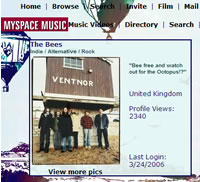 It’s expanded beyond this now and has now reached the point where record companies feel bands _must_ have their own presence on MySpace, even if they’ve got their own Web presence – witness sons of Ventnor, The Bees.
It’s expanded beyond this now and has now reached the point where record companies feel bands _must_ have their own presence on MySpace, even if they’ve got their own Web presence – witness sons of Ventnor, The Bees.
The hard-nosed commercial reality is that bands would be foolish not to be on MySpace. With 35m active users is claimed, the potential audience is too huge to ignore.
Here comes the competition
Other companies are well aware of the value of shared spaces like this – their attention focused by the $580m the News International paid for MySpace. This was highlighted by Microsoft spending a fair bit of cash at SXSW try to get the music companies interested in being on MSN Spaces – their looky-likey offering.
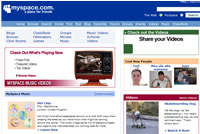 With the media footprint that News International has, it’s highly likely that they’re going to be able to make best value from what appears to be a considerable purchase price. Already there’s been reports their UK tabloid, The Sun, is to being brought onto MySpace using MySun.
With the media footprint that News International has, it’s highly likely that they’re going to be able to make best value from what appears to be a considerable purchase price. Already there’s been reports their UK tabloid, The Sun, is to being brought onto MySpace using MySun.
With the backing of Murdoch, MySpace _will_ become more of people lives than it is now, and they’ve reached such a point of saturation that the likelihood of them being displaced is low, at least in the short term. If reports of expansion are correct, UK and European residents can expect to be hearing a lot more about MySpace.
 Thanks to innovative manufacturers like Logitech, we’ve had mice (mouses?) with more buttons than a Cinderella reunion, but just when you thought that the humble mouse couldn’t get any more new features, Digital Cowboy have announced the world’s first dual pointer mouse, the DCT-DPM1.
Thanks to innovative manufacturers like Logitech, we’ve had mice (mouses?) with more buttons than a Cinderella reunion, but just when you thought that the humble mouse couldn’t get any more new features, Digital Cowboy have announced the world’s first dual pointer mouse, the DCT-DPM1. The DCT-DPM1 is aimed at people with multiple desktop displays, where users currently have to scroll across hefty distances when they jump from screen to screen.
The DCT-DPM1 is aimed at people with multiple desktop displays, where users currently have to scroll across hefty distances when they jump from screen to screen. Flipping between the two work areas is then simply a case of activating the mouse button to access the ‘parked’ cursor, without any need for a marathon of cross-screen scrolling.
Flipping between the two work areas is then simply a case of activating the mouse button to access the ‘parked’ cursor, without any need for a marathon of cross-screen scrolling. We’ve no idea when, or even if, this bi-cursorary device will be making it to the UK, but it is possible we could be witnessing the next evolution of the mouse.
We’ve no idea when, or even if, this bi-cursorary device will be making it to the UK, but it is possible we could be witnessing the next evolution of the mouse. 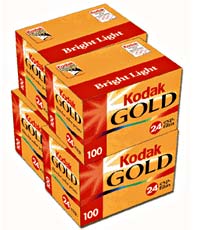 For the first time in its long history, Eastman Kodak is generating more annual sales from digital imaging than from film-based photography.
For the first time in its long history, Eastman Kodak is generating more annual sales from digital imaging than from film-based photography.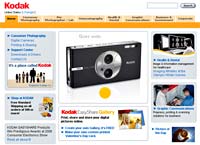 But it’s not all good news though, with the company reporting that total losses could top an eye watering $1 billion, as a result of the hugely expensive restructuring demands required by a potentially risky shift to digital.
But it’s not all good news though, with the company reporting that total losses could top an eye watering $1 billion, as a result of the hugely expensive restructuring demands required by a potentially risky shift to digital.  The company is still half way through the arduous task of restructuring the business for the digital world, and has already laid off some 25,000 workers.
The company is still half way through the arduous task of restructuring the business for the digital world, and has already laid off some 25,000 workers. Fortunately for Kodak, Christmas proved a highly profitable period with sales of its EasyShare Printer Docks surging 95%, and sales of kiosks to drugstores and other outlets up 23%.
Fortunately for Kodak, Christmas proved a highly profitable period with sales of its EasyShare Printer Docks surging 95%, and sales of kiosks to drugstores and other outlets up 23%.  The average laptop is stuffed full of data worth more than half a millon quid.
The average laptop is stuffed full of data worth more than half a millon quid. According to the study – taken from 1,700 quantitative interviews with general employees and IT managers – over three quarters of respondents (80 per cent) laboured under the misconception that their employer had a safe copy of all the emails on their PC.
According to the study – taken from 1,700 quantitative interviews with general employees and IT managers – over three quarters of respondents (80 per cent) laboured under the misconception that their employer had a safe copy of all the emails on their PC. Seven branches of the already-wireless central Seattle library are going WiFi. The
Seven branches of the already-wireless central Seattle library are going WiFi. The  Neither report, it seems, is talking of the inevitable spectrum conflict looming as domestic WiFi proliferates, and City WiFi spreads through the same areas.
Neither report, it seems, is talking of the inevitable spectrum conflict looming as domestic WiFi proliferates, and City WiFi spreads through the same areas.  “There is a long queue of companies waiting to undergo the same certification process. Then, they can proceed to ‘wave 2’, covering security and quality-of-service, and when they too are certified, we can expect to see larger numbers of products actually reaching the market,” was one comment. But Solis added:
“There is a long queue of companies waiting to undergo the same certification process. Then, they can proceed to ‘wave 2’, covering security and quality-of-service, and when they too are certified, we can expect to see larger numbers of products actually reaching the market,” was one comment. But Solis added: The buzz about the rebirth of the Internet has been getting louder for at least the last nine months as the label Web 2.0 was attached to the new generation of applications.
The buzz about the rebirth of the Internet has been getting louder for at least the last nine months as the label Web 2.0 was attached to the new generation of applications. It’s based on the Open-source software principles that are integral to true Web 2.0 apps – by giving away the application and providing tools for interested developers, a large community has grown up providing plug-ins that extend WordPress in many different directions. This benefits the users as well as the people behind WordPress – see how giving things away is a good thing?
It’s based on the Open-source software principles that are integral to true Web 2.0 apps – by giving away the application and providing tools for interested developers, a large community has grown up providing plug-ins that extend WordPress in many different directions. This benefits the users as well as the people behind WordPress – see how giving things away is a good thing? Yesterday afternoon, without much fuss, and with zero trumpets playing, Nikon UK announced that they are to stop production of nearly all of their analog cameras. Err … what did you say?
Yesterday afternoon, without much fuss, and with zero trumpets playing, Nikon UK announced that they are to stop production of nearly all of their analog cameras. Err … what did you say?
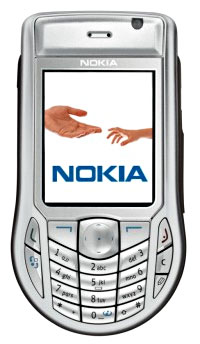 A new UK survey shows a dramatic increase in the use of picture messaging with WAP also growing in popularity.
A new UK survey shows a dramatic increase in the use of picture messaging with WAP also growing in popularity.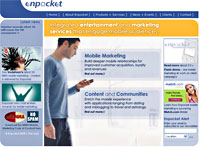 When it comes to seeking mobile information online, it’s the geezers who are keenest to get their keypads rattling, with 38% accessing mobile Internet (WAP) sites compared to 26% of ladies.
When it comes to seeking mobile information online, it’s the geezers who are keenest to get their keypads rattling, with 38% accessing mobile Internet (WAP) sites compared to 26% of ladies. Elsewhere, the Mobile Data Association have calculated that WAP page impressions are now approaching the 2 billion per month mark, with the Mobile Media Monitor revealing the most popular types of site on the mobile internet.
Elsewhere, the Mobile Data Association have calculated that WAP page impressions are now approaching the 2 billion per month mark, with the Mobile Media Monitor revealing the most popular types of site on the mobile internet.  We like “world firsts” so when integrated-circuit providers Micronas announced that they were the planet’s first company to incorporate a Dolby Virtual Speaker into a chipset designed specifically for televisions, we simply had to tell you all about it.
We like “world firsts” so when integrated-circuit providers Micronas announced that they were the planet’s first company to incorporate a Dolby Virtual Speaker into a chipset designed specifically for televisions, we simply had to tell you all about it.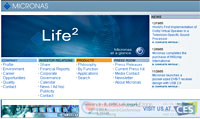 Dolby Virtual Speaker creates the illusion of five speakers by using room modelling techniques. This, apparently, sets it apart from other virtualizers.
Dolby Virtual Speaker creates the illusion of five speakers by using room modelling techniques. This, apparently, sets it apart from other virtualizers.  NBC Universal and Apple have struck a deal to make NBC-owned television shows, such as “The Office” and “Law & Order,” available on the iTunes music store.
NBC Universal and Apple have struck a deal to make NBC-owned television shows, such as “The Office” and “Law & Order,” available on the iTunes music store. The shows will be available from next week, downloadable from the iTunes Music Store the day after they air for $1.99 (£1.15, €1.70) per episode
The shows will be available from next week, downloadable from the iTunes Music Store the day after they air for $1.99 (£1.15, €1.70) per episode